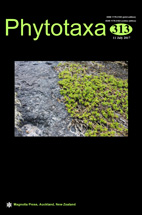Abstract
The correct determination of host plants is essential for identifying species of rust fungi (Pucciniales). During studies of rust fungi on Annonaceae, it has been shown that the host plants of Aecidium annonae, Aecidium annonaceicola, Aecidium chrysophaeum and Cerotelium xylopiae have been wrongly labeled as species of Annonaceae. The hosts of these species were newly determined to belong to the genus Diospyros (family Ebenaceae) using anatomy and micromorphology. Aecidium annonae and A. annonaceicola are conspecific, as also confirmed by their common host Diospyros hispida. The real host of A. chrysophaeum is Diospyros artanthifolia. The new species name Cerotelium diospyri, referring to its host plant Diospyros sericea, is proposed to replace the misleading name Cerotelium xylopiae, an invalidly published name.

